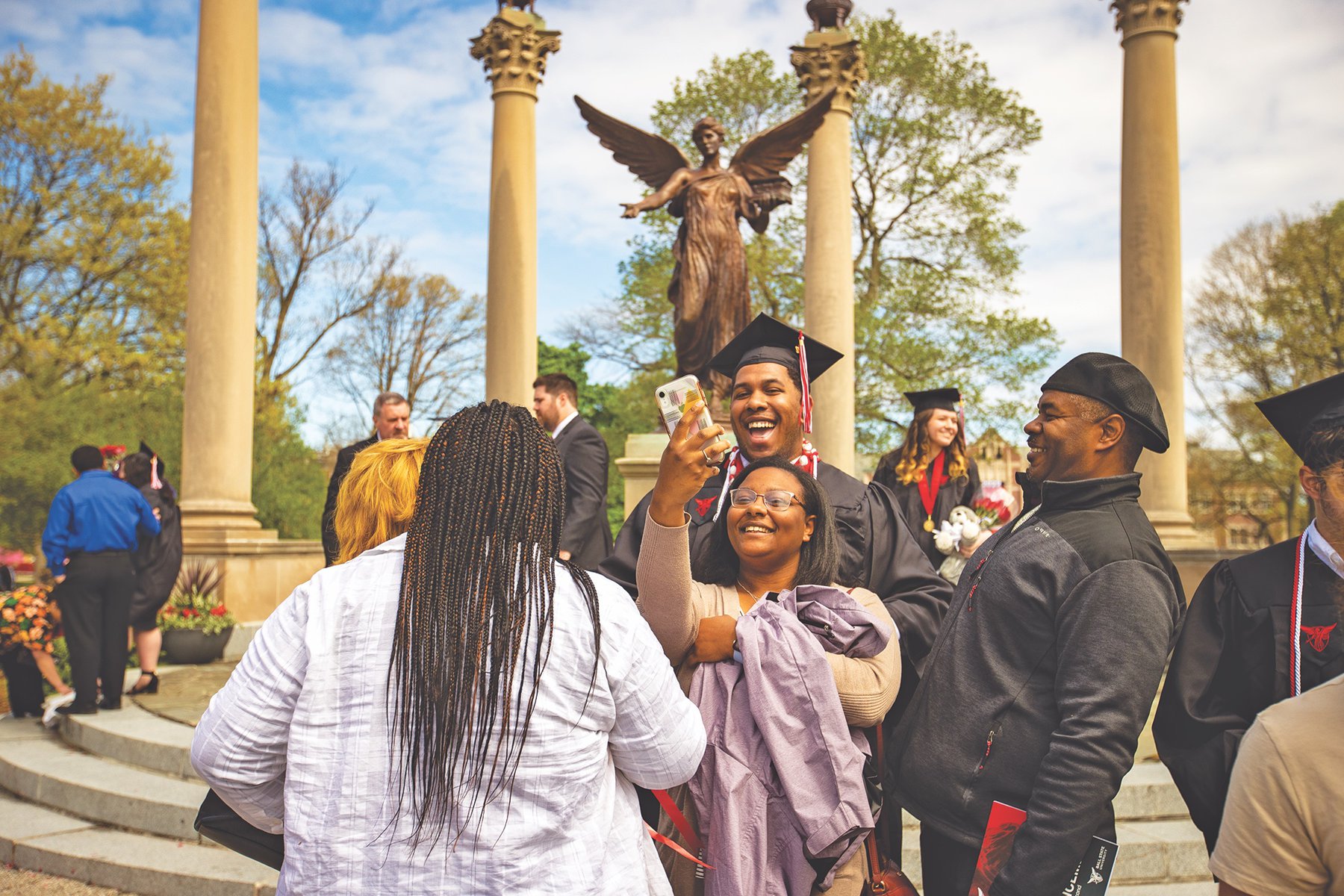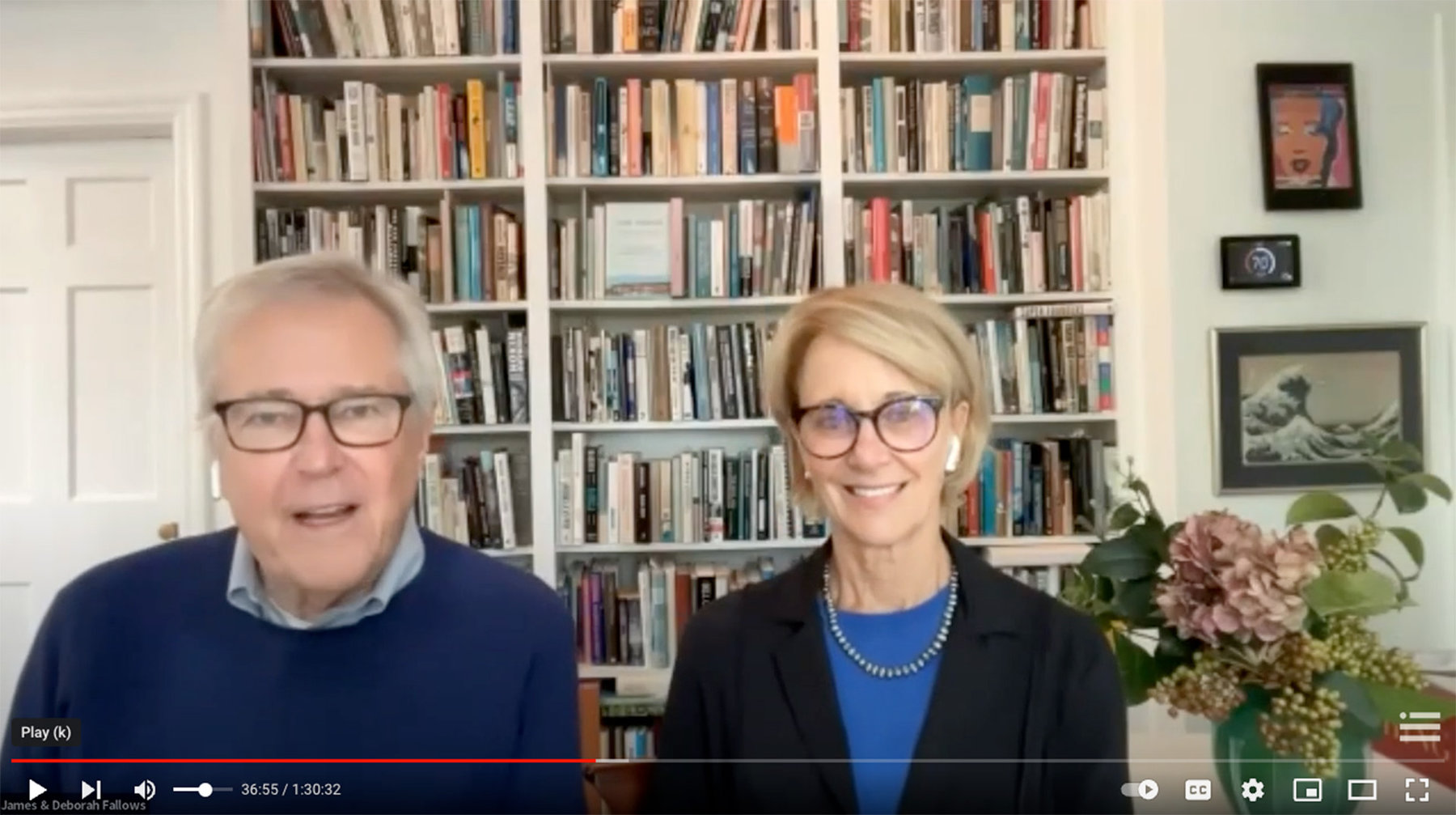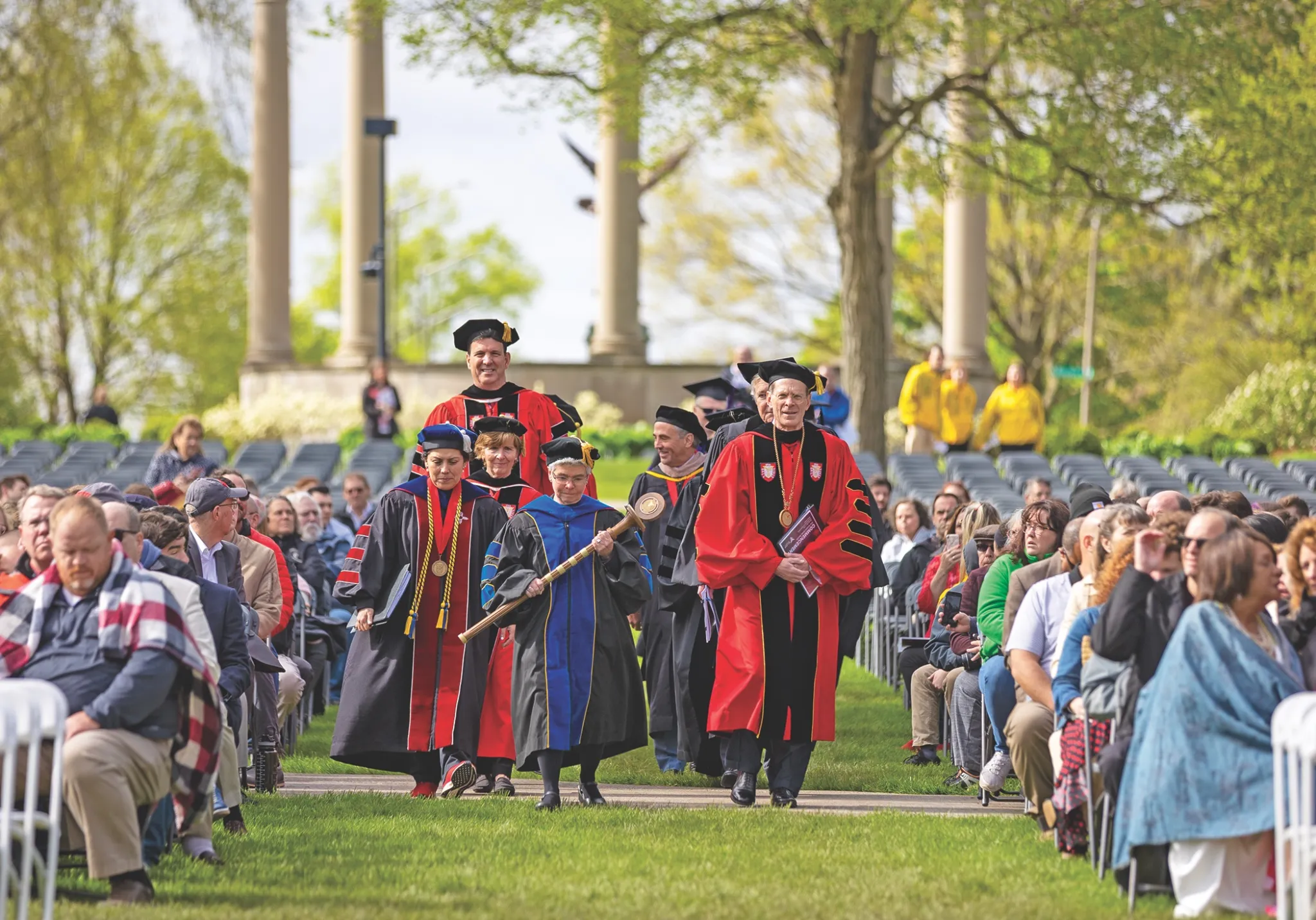As described in this post, Deb Fallows and I are long-time supporters of The Washington Monthly, where I had my first magazine job exactly 50 years ago. In their latest college-guide issue, I had this article about the way Ball State University, a large public research university in Muncie, Indiana, has assumed moral and practical responsibility for improving life in its home town.
One of its central themes is the importance of this kind of university-based innovation in communities. Another is the near-total invisibility of reports on such efforts in the national media. As described here, Americans need a fuller picture of modern America.
The article is reprinted here with The Washington Monthly’s approval, and with our thanks.
1) “Let’s do it.”
An hour before dawn on May 7, Geoffrey Mearns stepped out of his house in Muncie, Indiana, and started to run with his dog, Cadi.
That made it a normal morning for Mearns. Decades ago, in high school in Cleveland, he had been a distance-running star, and at Yale he set records in track and cross-country. His marathon times qualified him for the 1984 U.S. Olympic trials, which he missed because of a foot injury. Now in his early 60s, Mearns has the look of a man who could still outrun everyone around him and has never fallen out of shape.
The stakes on that morning’s run were unusually high. For the past five years, Mearns had been the president of Ball State University in Muncie, a large-enrollment public research institution. Why the name? A little more than 100 years ago, the five Ball brothers of Muncie, who became rich and famous through the iconic glass jars with a Ball signature and Ball home canning equipment, bought the land and buildings of a bankrupt private college and gave it to the state as a public university. Ball State’s student body now numbers more than 20,000.
Before the sun came up that Saturday morning, Mearns had to make a choice with short-term consequences for the university and at least symbolic connections to larger choices, and gambles, the institution had made during his tenure.
The immediate choice involved the weather, which was terrible. For the past few days, heavy rain had moved over the Midwest—and refused to budge. On Friday, Mearns had chaired trustee meetings and gala receptions on campus. Attendees had scuttled under umbrellas to avoid getting drenched.
One of the soggiest parts of campus was the sweeping grass sward of the elegant outdoor quadrangle, now a flooded turf with several thousand folding chairs, carefully laid out for Ball State’s first commencement ceremony on the traditional quadrangle since the pandemic began. The choice Geoffrey Mearns said he would make by sunrise was whether to move the ceremony inside, to the basketball arena.
Mearns ran around the quadrangle and looked at the sky, checking and rechecking the weather radar on his phone. Around 6 a.m., he called his staff associates and his wife, Jennifer, to say, as I heard him put it later that morning, “Let’s do it.” The commencement would be outside. It was still drizzling as he made the call.
At 10 a.m., in a bright red academic robe, Mearns welcomed the graduates, who were seated on 10,000 chairs that had just been wiped and blown dry, to a providential beginning of the next stage of their lives.
Of course, it wouldn’t really have mattered if the call had been wrong—if the rain hadn’t cleared, if the sun hadn’t broken through until midday. I’ve sat through wet commencements before. They can make for rueful but proud reminiscences years afterward. (“Well, things started out tough …”) In this case, my wife, Deb, and I would have been among the rained-on at Ball State, with stories to tell; we had come to give commencement addresses and accept honorary degrees. But the rain had stopped, and we were in the procession, walking carefully over the slippery grass behind Mearns.
The reason we were there, and had come to know the Ball State community over the previous three years, was our belief that the “Let’s do it” spirit of Mearns’s bet about the weather, while of minor consequence on its own, was connected to larger gambles and commitments Ball State has made. (The university’s motto, “We Fly,” is just a more elegant version of “Let’s do it.”)
Over the past five years, the most dramatic step Ball State has taken might also be the most consequential for Muncie. In 2018, the city turned the management of its entire K–12 public school system over to the public university, something with no clear precedent in American higher education history.
This takeover, unlike the weather forecast, is genuinely important, and Deb and I think what we have seen in central Indiana matters. It and developments like it have attracted little or no attention from the national press. But we think they are an introduction to an important new era of colleges, college leaders, and “college towns.”
2) The story of college towns …
Let’s start at the end, with “college towns.” The term is a reminder that having a nearby college has different implications for a community than having a factory or an office park. Small liberal arts colleges, big research universities, ambitious community colleges, HBCUs, tech schools, specialized academies, religious institutions—these and other kinds of schools have always given college towns special advantages.
There are small towns closely identified with small liberal arts colleges. In Massachusetts, Amherst the college—and the town. In Ohio, Oberlin. In Kentucky, Berea. In Tennessee, the University of the South, at Sewanee. In eastern Washington, Whitman.
There are elite universities that have transformed the economies and possibilities of their regions. The Harvard/MIT cluster in Cambridge and greater Boston. Stanford, UC Berkeley, and UCSF in the Bay Area of California. Carnegie Mellon and the University of Pittsburgh, in Pittsburgh. UCSD in San Diego. Caltech as a center of the aerospace industry in Southern California. The University of Utah and Brigham Young, in the Salt Lake City/Provo area. The North Carolina universities that give the “research triangle” its name. Any study of the growth of these areas has chapters on these colleges’ roles.
There are big land grant and state institutions that have become the technology-and-culture centers of entire regions. Ohio State University in Columbus. Wichita State in central Kansas. Penn State in central Pennsylvania. The University of Texas in Austin. A full list could take the rest of this article.
And there are particular institutions that have become thin reeds, barely propping up the economies of their surrounding areas. To enumerate them would be cruel. I’ll just say that some rural communities have tied their economic fate to jobs in the prison-industrial complex. Those tied instead to the small-college economy have struck a better bargain. A draw of professional talent into the community. A better chance that young people who come for “institutional” reasons will want to stay and build.
… and of college leaders
The ramifications of being a college town are familiar—as are the gaps between colleges and the communities in which they are located, which is why we say “town and gown.” What is new is how an under-noticed generation of college leaders is deciding to use their institutions as deliberate instruments of community, civic, and regional advancement.
What a seaport was to growing communities in the 1600s, what waterfalls for producing power were in the 1700s, what railroad connections were in the 1800s, and on through the years, ambitious colleges can be to communities of our era. The Washington Monthly has rightly focused on colleges as engines of individual mobility, social responsibility, and national cohesion. In this and upcoming stories we will be publishing in the Monthly, Deb and I will report on colleges we’ve seen, from Oregon to South Dakota, Mississippi to Maine, that have invented new ways of creating community and regional opportunity.
It’s a trend that could become a movement. And it depends on “Let’s do it” leadership, even in an era of college leaders generally trying to keep their heads down.
This is a walking-on-eggshells moment for many college presidents. Quick: How many current presidents of Ivy League schools can you name? Of other major research universities? Of famous small colleges? My own list runs out quickly. It’s a time in which many leaders survive by not being noticed.
They worry about money. They worry about politics and legislatures. They worry about pressure from students, parents, faculty, and trustees—not to mention journalists and community members. And again: They worry about money.
They’re fearful of a misstep—literally, on the soggy turf of a possibly rained-out commencement; symbolically, in myriad other ways. Robert Maynard Hutchins was famous as a 30-year-old president of the University of Chicago; Edward Levi and Hannah Holborn Gray, as two of his successors; Kingman Brewster Jr. at Yale; Drew Gilpin Faust at Harvard. Father Theodore Hesburgh at Notre Dame; Freeman Hrabowski III at the University of Maryland, Baltimore County. Their counterparts and successors operate in more perilous terrain. Today, the best-known exception illustrating the rule is Michael Crow, who, as president of Arizona State University, has innovated in countless ways, from partnerships with businesses to radically expanded access for students from noncollege backgrounds. As has often been argued in these pages, the U.S. News & World Report’s college rankings are a net loss to both educational progress and human well-being. (For the record: I once was editor of that magazine.) But they’ve done one thing right: Since U.S. News first established a “most innovative” category in 2016, Crow’s Arizona State has always been at the top of the list.
We’d like to introduce you to less-well-known exceptions, which we hope and believe will amount to a trend. The theme of the stories beginning in this issue and followed up in coming months will be a one-two punch. The first is leaders’ decision to take risks in the public interest. The second is their imagining their colleges’ interest as extending beyond the campus to the community and region.
This brings us back to Muncie.
3) Running toward the challenges
After his track career and a few years as a private school English teacher, Mearns decided to become a lawyer. He went to law school at the University of Virginia, clerked for a federal judge in Louisville, worked briefly for a New York law firm, and, in 1989, became a federal prosecutor in Brooklyn. He spent about nine years in that role, including advising on the Oklahoma City bombing cases. During his time as a teacher he met and, as he tells it, eventually gained the attention of Jennifer Proud, who then worked in media relations for Madison Square Garden and later had a similar role for the men’s pro tennis tour. They were married in 1988 and have five grown children.
In 2005, while in private legal practice in Cleveland, Mearns was recruited to go into academia as the dean of the law school at Cleveland State. A few years later, he and Jennifer moved to northern Kentucky, across the Ohio River from Cincinnati, where he was president of Northern Kentucky University. In 2016, they considered coming to Ball State.
The job itself was a step up in scale. The question—as they both now say—was: Muncie? Seriously? The city, with a current population of around 65,000 (down from its peak of about 75,000 in the 1980s), is famous in the world of sociology as the locale for Robert and Helen Lynd’s classic Middletown: A Study in Modern American Culture, based on research almost 100 years ago. Muncie is also well known in the world of economics as one more case study of the damaging effects of corporate disruption and relocation. Much of the Ball family’s wealth still makes a difference in Muncie, but they no longer control the company, which is not based there anymore. Ball State as an institution remained strong. The city did not. That is what the Mearnses realized when they came to town for a final interview.
“If you drive from northern Kentucky to Muncie, the fastest way takes you through the south side of the city,” Mearns told me recently. “If you’ve driven or walked through the south side of Muncie, you see a very different community than the one that exists here on the north side, near our campus.” That different Muncie was more boarded up, poorer, and racially less white. “Frankly, after we took that drive and on the ride back to Kentucky, we thought long and hard about whether this is a place we wanted to live.”
They decided that it was—because of its struggles, not in spite of them. (“Let’s do it.”)
“The next conversation I had with the board, I said if you want a president whose plans are confined to the four corners of campus, I’m not the right person,” Mearns recalled. “If you want somebody who is going to use the assets and innovative thinking of a large public research university for change in Muncie, I’m interested, too.”
This may sound like boilerplate. I will tell you that talks with people in Muncie over the three-plus years since our first visit—Black and white, academics and journalists, within the Ball State community and outside, students and alumni—reinforced our sense that the university has not just talked the talk. It has walked the walk.
4) A public college running public schools
What does this mean in practice? Ball State has long been connected with the community. Back in the 1880s, the Ball brothers moved their company to the area from Buffalo because its natural gas supplies helped in glassmaking. In modern times, the area has great geothermal potential. More than a decade ago, Ball State began building one of the largest geothermal heating and electricity projects of any university in the country. Under an earlier president, Jo Ann Gora, Ball State launched a program of “Immersive Learning,” an American version of apprentice training.
The university also has had a tradition of charitable giving, and in 2019 it launched One Ball State Day, a fund-raising effort for local causes that this year brought in more than $1 million.
Mearns’s contribution to this tradition has been spearheading the university’s extraordinary involvement in the city’s public K–12 system. The story of the Muncie Community Schools (MCS) since the 1980s is a familiar one in urban America: attendance declined; the tax base shrank; teachers left; the downward cycle intensified. Almost five years ago, about the time the Mearns family decided to move to Muncie, the Indiana legislature took the drastic step of putting two of the state’s public school systems, those in Gary and Muncie, into state-run emergency receivership.
That is where Ball State stepped in, with a wholly unfamiliar approach. A few months after taking office, in a move that had been coordinated within the university but took many legislators by surprise, Mearns proposed that Ball State—which had started in the 1800s as a “normal school,” training teachers, and which still has the largest teacher’s college in the state—assume responsibility for Muncie’s schools. Financing, management, labor relations, curriculum—everything. The ensuing saga was complicated and dramatic, and I wrote a whole article about it soon after it occurred. The closest parallel was Boston University (a private institution) running the schools in the Chelsea area of the city.
In Muncie, the essence was a radically transparent and inclusive way of having a university and a whole community take responsibility for community schools. This wasn’t the gown bossing around the town. Under the emergency legislation that Mearns proposed to the legislature, he and the Ball State board would appoint members of the new community school board. The measure passed, and they solicited applications from across the town. Of the 88 applicants, they invited 20 finalists to appear at a two-hour televised event, and the seven board members who emerged from the process were a diverse sampling of Muncie. They included a special-ed teacher with school-age children, the YWCA’s executive director, a lawyer and former head of the Ball State University Foundation, a local banker, a Ball State official, a pastor, and a former state court judge. They were five men, two women; five white, two Black; six of the seven had attended Muncie Community Schools. I made notes about the selection process at the time:
I met with board members for an hour last month in Muncie and asked each of them why they’d decided to apply for this post. “I couldn’t not throw my hat into the ring, because the challenge is so important,” the lawyer, Mark Ervin, told me. “If you have a chance to make a difference, you take it. You don’t have that many chances.” Brittany Bales, the special-ed teacher, had taken her young children out of the Muncie schools but brought them back. “It’s a mirage that it’s better somewhere else,” she said. “It’s more diverse and interesting within MCS.”
The turnover happened four years ago. This year, Mearns gave the Ball State board an update on the experiment: Enrollment is stabilized. Finances are dramatically better. Teacher pay is up by nearly 40 percent. Teacher retention has improved from 67 percent to nearly 90 percent. There’s still a long way to go, as Mearns and others emphasize. But the changes have been in the right direction.
After Mearns’s presentation, the board approved his proposal to reappoint the community school board members whose terms were expiring. “If you look at what we’ve done here, it’s an extraordinary connection between university and city—the city council, businesses, not-for-profits, and all others,” one board member said. “I think with Ball State stepping up to take the lead in this case, it’s shown how we in Muncie can be an example of working together.”
As far as I can tell, Ball State’s commitment to Muncie schools has never been featured in the national news. The education press is the only place it seems to have been mentioned at all. A billion stories about “polarization in the heartland”; a million on the plight of public schools. Few or none about a dramatic and creative attempt at reform.
Ball State has other community projects. One is the development of a nearby struggling area called “the Village.” This follows a pattern seen in many college towns: using the economic leverage of a college to begin the process of reclaiming left-behind districts. Obviously, it could bring risks of gentrification and related ills. Those are genuine problems, but they’re better problems to deal with than those of decline.
There is also a region-wide consciousness to Ball State’s plans. The higher ed business is going through profound economic dislocation. Some of the most vulnerable institutions are the small private colleges that do not have the brand name of Oberlin or Amherst. Many are across the Midwest, including in Indiana. Mearns believes that Ball State can extend its “college town” alliance to include the biggest research universities in the area, which means Indiana University and Purdue; the community colleges, which across Indiana are all called Ivy Tech; and a number of the endangered smaller private colleges.
“In a way, we’re competing for students,” Mearns said of these institutions. “But in a bigger sense, we can all help one another, and the state.”
5) A trend, becoming a movement
This is one story about one institution, in one community, that has plenty of work ahead. I can’t say that it yet represents a movement. There are too many wealthy colleges that try to wall themselves off from their communities. But colleges’ commitment to their communities could become one more way we assess them. And it should.
Some examples we’ve learned about firsthand, for upcoming reports:
• In Watertown, South Dakota, the Lake Area Technical Institute’s student body is mainly first-generation college students—virtually all of whom are employed after graduation at wages far above the national median.
• In Waterville, Maine, Colby College was considering moving out of town a century ago, probably to Augusta, to expand beyond its cramped location between the railroad tracks and the Kennebec River. Citizens of Waterville somehow raised $100,000—a fortune in those days—for a new plot of land for the college, where it has been based ever since. Now Waterville has struggled as mills have closed and jobs have disappeared—and the college is investing in the community’s recovery. “When the chips were down, the community really came through for the college,” Colby’s current president, David Greene, told me. “For us, this is a moral obligation and a sense of our future. You’re in partnership with your community, and you need to be there in bad times as well as good.”
• In Dayton, Ohio, one of the nation’s oldest community colleges, Sinclair, and the Catholic-run University of Dayton have pooled their efforts to create jobs in an area where factories have closed, and to revive a long-struggling downtown. “Our communities need institutions that are anchor institutions,” Eric Spina, the president of the University of Dayton, told me recently. “These colleges are some of the few institutions left standing that care about place, that care about home.” In upcoming reports we’ll hear more from him, and many others like him.
6) We fly.
America’s oldest college has the motto “Veritas,” for truth. Its second-oldest Ivy has the motto “Lux et Veritas,” light and truth. I’m in favor of both ideals.
But at this moment, I welcome colleges whose motto could be “Communitas.” Or, since some schools already have that motto, I’ll loosely mistranslate it:
Together, we fly.




